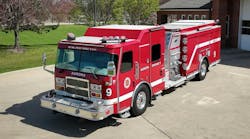This column is a component of VFIS' "Operation Safe Arrival" initiative, aimed at heightening safety awareness and reducing the frequency and severity of accidents involving emergency vehicles.
Contrary to popular belief, rollovers are not the trick that you try to teach your firehouse Dalmatian. The term also holds more than financial connotations: it is not what you plan to do with your CD or IRA. Rather, this article explores another use of the term, namely rollover accidents with emergency vehicles. A majority of the time such accidents involve tankers. However, it is important to note that VFIS has had rollover accidents with every conceivable type of emergency vehicle.
Rollovers are costly. VFIS statistics show that vehicle rollover damage is 15 times more costly than other types of collision damage. When they occur, there is substantial damage to the vehicle. Damage generally occurs to the drive train, pumps, engine and transmission along with the expected damage to the body and cab. The normal time period for the vehicle to be out of service is six to nine months. Having a major piece of response equipment out of service for that long can have a major impact on your response capabilities.
Rollovers also cause severe injuries to your driver and other personnel. The 2003 NIOSH Firefighter Fatality and Prevention Annual Report indicate that five fatalities were the result of rollover accidents. But emergency responders aren't the only ones who could be affected. A patient being transported in an ambulance involved in a rollover also stands a good chance of being injured.
What is the problem and what are the scenarios VFIS is seeing in our losses?
The most common occurrence we see is a heavy vehicle with a high center of gravity rounding a curve on a rural road. The speed is too fast, the right side wheels travel off the side of the road onto a soft shoulder. The driver tries to correct by turning the wheel sharply to get the vehicle back on the road. When the wheel is turned, the vehicle travels across both lanes onto the opposite shoulder where the driver again over steers. At this point the vehicle rolls due to the weight and momentum shift.
Many factors can aggregate the problem. Rate of speed is very important. If the driver reduces speed and does not try to bring the vehicle back on the road, a rollover may be prevented; if the driver tries to correct without reducing speed, a rollover is usually inevitable. If the vehicle is a tanker and has no baffles, the shift of momentum is even greater. Lack of appropriate training can play a role as well as weather conditions that cause icy, snow-covered or wet roads.
What should your organization do to help prevent rollovers?
Training & More Training
VFIS encourages emergency service organizations to provide as much training on these vehicles as they can. Drive them on all types of roads and in all types of weather in your area. The VFIS Vehicle Rollover Prevention Communique, which can be found at www.vfis.com, includes some excellent safe driving suggestions on what the driver should do to minimize the likelihood of rollover.
Experience & More Experience
The operators of the heaviest vehicles should be your most experienced drivers. Granted, inexperienced drivers need to gain experience operating these vehicles, but allow them to do so during training.
Slow Down
When you're responding to an incident, you absolutely need to get there, first and foremost. Rollovers prevent you from doing that. What is the correct speed? Is it 10 mph over the speed limit? Is it the speed limit? Or is it under the speed limit? Depends on a lot of factors, including road construction, stability, traffic, and weather conditions. The leadership of the organization should be developing those standards per your response area. Some responses on roads, due to maintenance and curves, should be run below the speed limit. Pre-plan your routes and include weather conditions when you're thinking about that response and speed.
Maintenance
Make sure your vehicles are well-maintained, not overweight, and equipped with baffles in the tanks. In addition, ensure that chassis and brakes must be appropriate for the vehicle. Well-designed and maintained vehicles contribute to the overall confidence of the driver and the safe driving of the vehicles.
Safety
Last, but certainly not least, provide seatbelts in all your vehicles and mandate that they be used prior to pulling the vehicle out of the station. There's no excuse for not having them or for not using them. Obviously this won't prevent a rollover, but it will lessen the impact to the organization.
Related Articles:
- Don't Become A Statistic
- Developing Procedures For Emergency Vehicle Response
- Safe Intersection Practices
- Responding In Personal Vehicles
- What's Your Speed Limit?
- Lights, Sirens...Action!
- Emergency Vehicle Driver Training: More Important Than Ever
- Selecting Emergency Vehicle Drivers
- Taking Control of Traffic - Electronically
- Emergency Vehicles and Intersections: Educating the Public
- Event Data Recorders - The "Black Box" for Safer Response
- Emergency Vehicle Driving and Traffic Preemption
- Does Motivation Affect Firefighters?
- Emergency Vehicle Response Near Misses
- Highway Safety: A Practical Approach
- The Importance of Motor Vehicle Record Check Programs
- Safe Passage - The Public's Responsibility?
- Braking - Friction at Work
- VFIS Operation Safe Arrival Website





